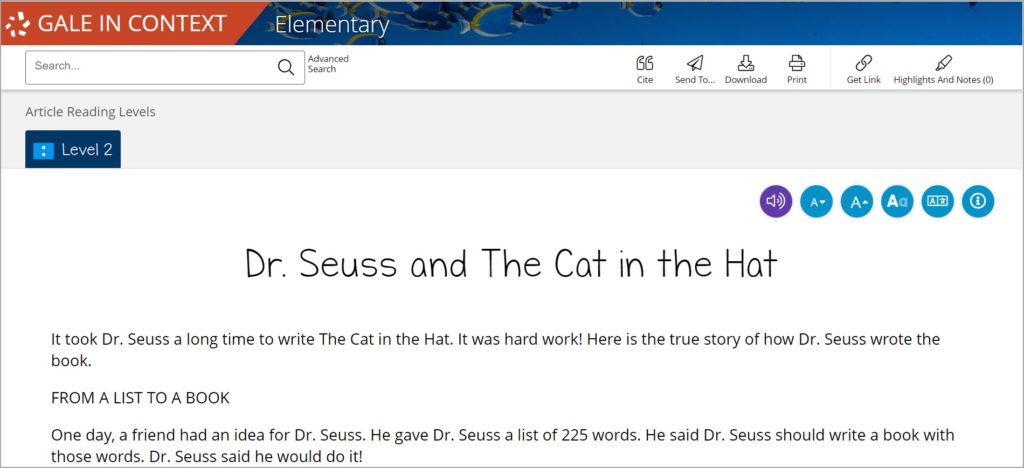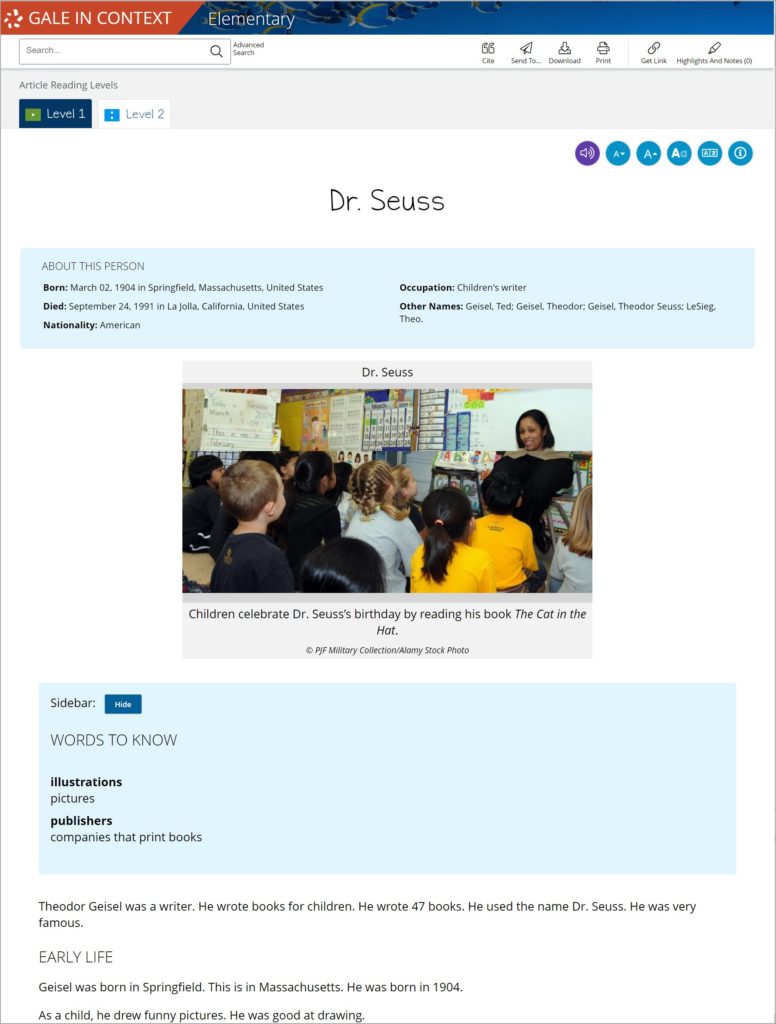| By Gale Staff |
Theodor (Ted) Seuss Geisel, better known by his pen name Dr. Seuss, is not a doctor at all. He is one of the most beloved authors of all time, writing and illustrating dozens of children’s stories and inspiring millions to fall in love with reading. His colorful characters and charming rhymes are accessible for children yet rich with lessons that we can lean on throughout our lives. This March, why not celebrate his many contributions in your own classrooms and learning spaces? March 2 marks the official birthday of Dr. Seuss, and Gale In Context: Elementary is your go-to source for Dr. Seuss news, pictures, and other fun resources.
In honor of Dr. Seuss, the National Education Association created National Read Across America Day in 1998 to celebrate his birthday each year. While the agency has shifted from Dr. Seuss-specific books to highlight other diverse voices, the holiday’s mission remains very much in line with that of Dr. Seuss—helping more children discover a love for reading.
You can find a curated collection of Dr. Seuss-related news articles, images, and biographical pieces for your class to explore. Or, read the lore behind some of his most popular works. It’s all housed in Gale’s user-friendly digital content library and ready for you and your students to dive into!

Discover the Man Behind the Magic
With a bibliography that includes iconic works like How the Grinch Stole Christmas and The Cat and the Hat, you’d think Dr. Seuss needs no introduction. But the truth is, your students, while no doubt familiar with his stories, probably know very little about Theodor Seuss Geisel himself.
Ted Geisel was born in 1904 in Massachusetts. Growing up, he was an avid writer and cartoonist. When he was 32 years old, he wrote his first book, And to Think That I Saw It on Mulberry Street. He developed his knack for rhyming from his mother, and while his success in children’s literature was somewhat unintended (Green Eggs and Ham was created because of a $50 bet), he became a leading advocate for the importance of children’s literacy. His stories have been published in more than 40 languages, and he won three Caldecott Honors as well as a Pulitzer Prize.
Encourage Your Students to Explore His Works
The Dr. Seuss collection is extensive, with some books more obscure than others. In honor of his birthday, introduce your classes to lesser-known stories with some curious characters. In fact, just a few years back, a previously undiscovered Dr. Seuss story, What Pet Should I Get, was published for the first time. It tells the story of two children exploring a pet store. But that’s not all! Currently, there are even more books in the works. A team of Seuss-inspired writers and illustrators is creating a collection of more inclusive Dr. Seuss stories to make up for the lack of diversity in his original books.
Activity Idea: For teachers, take a field trip to the school library to see what Dr. Seuss books you can find together as a class. For librarians, pull a few lesser-known Dr. Seuss stories from your collection and put them on display.
Celebrate Dr. Seuss with Your Young Readers
You can find endless ways to integrate the whimsical world of Dr. Seuss into your activities with young learners. Gale In Context: Elementary features built-in lesson plans and discussion ideas; plus, our recommendations always keep your common core standards in mind. You might also visit the official Dr. Seuss website, which publishes its own classroom activity ideas. For example, read Green Eggs and Ham as a class and ask students to share a time when they tried a new food too. Perhaps build a Dr. Seuss trivia quiz and have your students find the answers in Gale’s Dr. Seuss biographical entry (this can be adjusted by reading level to better meet your students’ needs). Or, using inspiration like Dr. Seuss’s Lorax or Grinch, have your students create their own imaginary characters. What does the character look like, and what makes this character unique? You can decorate your classroom or library with their inventive characters.

As Dr. Seuss famously said, “A person’s a person, no matter how small,” and it’s never too early to introduce your young learners to the basics of research and active reading. With Dr. Seuss’s stories, it’s easy to engage elementary students. His colorful characters and playful prose will help children improve their reading abilities and teach them how to fall in love with books.
Ready to explore the wonderful world of Dr. Seuss? Become a Gale subscriber today to start creating memorable learning moments with your students.

